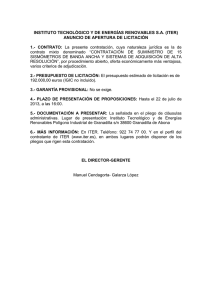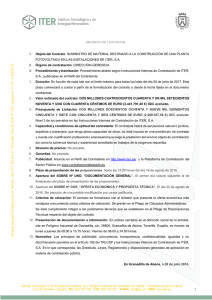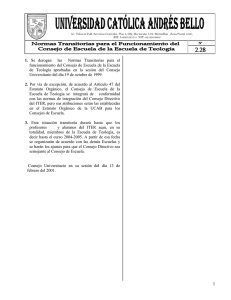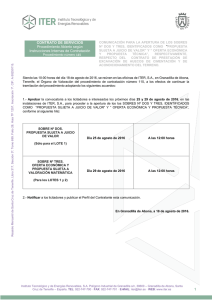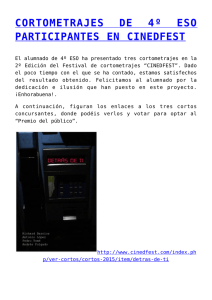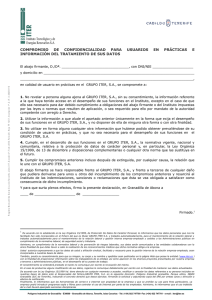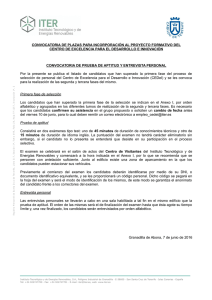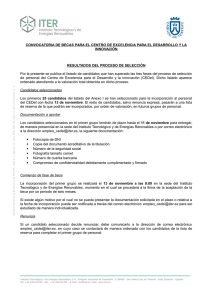Presentación de PowerPoint
Anuncio
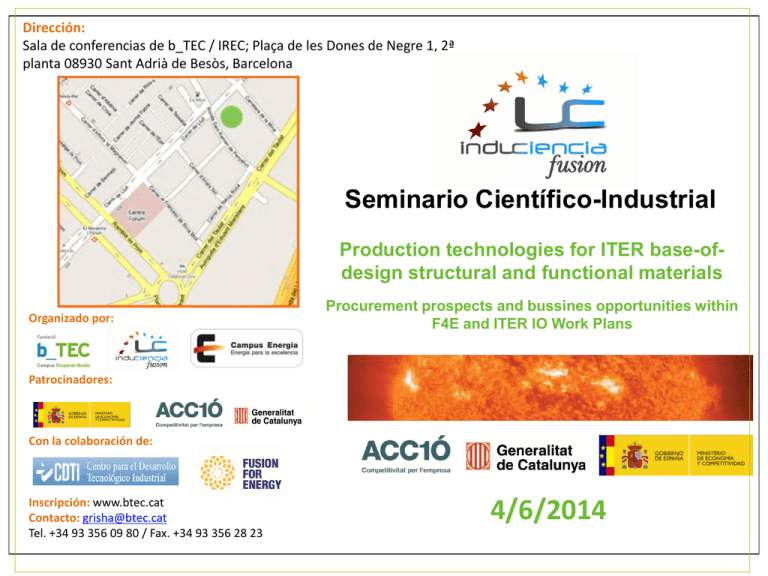
Dirección: Sala de conferencias de b_TEC / IREC; Plaça de les Dones de Negre 1, 2ª planta 08930 Sant Adrià de Besòs, Barcelona Seminario Científico-Industrial Production technologies for ITER base-ofdesign structural and functional materials Organizado por: Procurement prospects and bussines opportunities within F4E and ITER IO Work Plans Patrocinadores: Con la colaboración de: Inscripción: www.btec.cat Contacto: grisha@btec.cat Tel. +34 93 356 09 80 / Fax. +34 93 356 28 23 4/6/2014 LITIO ENRIQUECIDO EN Li-6 Eutéctico Litio-Plomo: Pb-6Li Características de base del material, rutas de producción, demandas y oportunidades en aprovisionamientos Luis Sedano Seminario Científico-Industrial Production technologies for ITER base-of-design structural and functional materials Procurement prospects and bussiness opportunities within F4E and ITER IO Work Plans Aspectos • Necesidad de regeneración de tritio en FN y materiales regeneradores. • Eutéctico de Pb-6Li como material estratégico en TNF. • Pb-6Li: características básicas y avanzadas. Demandas de QA como material nuclear. • Demandas de aprovisionamiento ITER y Programas. Demandas DEMO. Enriquecimiento 6Li en ITER y DEMO. • Cuestiones de I+D hacia el aprovisionamiento industrial. • Pb-6Li: Oportunidad industrial y de emprendimiento. • A modo de conclusiones. Production technologies for ITER base-of-design structural and functional materials Procurement prospects and business opportunities within F4E and ITER IO Work Plans Aspectos • Necesidad de regeneración de tritio en FN y materiales regeneradores. • Eutéctico de Pb-6Li como material estratégico en TNF. • Pb-6Li: características básicas y avanzadas. Demandas de QA como material nuclear. • Demandas de aprovisionamiento ITER y Programas. Demandas DEMO. Enriquecimiento 6Li en ITER y DEMO. • Cuestiones de I+D hacia el aprovisionamiento industrial. • Pb-6Li: Oportunidad industrial y de emprendimiento. • A modo de conclusiones. Production technologies for ITER base-of-design structural and functional materials Procurement prospects and business opportunities within F4E and ITER IO Work Plans • Necesidad de tritio en reactor de fusión DT: 55.8 kg/GWt-a (20), (14), (3), (2), (1), (4) (1) • Producción de CANDUs ~ 1-2 Kg/GWt-año. • Extrapolación optimista de APT ~ 12 Kg/GWt-a (blancos de espalación Li/Al diseñados ex-professo.) • Decaimiento de tritio 4.57% por año Capacidad aprov. de tritio (HWR) para FN ~ 27 kg ! Production technologies for ITER base-of-design structural and functional materials Procurement prospects and business opportunities within F4E and ITER IO Work Plans Joaquín Sánchez 1 atomo de T s 3 grs de T x 500 MWth x 440 x 0.389 grs. T (por pulso) 17.59 MeVx 1.60 x 10-19 pulso 6.022 x 1023 atomos de T • 1.5 % de disponibilidad operativa real: 11751 pulsos 4.57 Kg • 10 a de operación, 3000 pulsos/año (PP ~ 0.3 MWa m-2 < 3dpa): 11.67 Kg Production technologies for ITER base-of-design structural and functional materials Procurement prospects and business opportunities within F4E and ITER IO Work Plans SUCEDE • Inventario de tritio en 1999: 15 kg • Tasas de recuperación en 1999: 2.1 kg/a, decrece a 1.7 kg/a en 2005, cte. hasta 2025 • En 2025 los reactores alcanzan su final de vida y caen las tasas de producción de tritio • Ontario Power Generation (OPG) tiene 13 de sus 20 CANDU reactores operativos • Reactores con licencia de operación x 40 años • OPG vende 0.1 kg/a a usuarios externos a ITER/VNS (precio 70-120 M€/Kg) • Tritio decae a 4.57 % / año Escenario de Mercado (civil) del Tritio NO OCURRE: • Escenarios de arranque D-D/TBR con producción de tritio • Extensión de tiempo de vida de los CANDU a 60 años • Re-arranque de los CANDU parados • Construcción de nuevos CANDU • Entrada en el mercado civil de tritio proveniente de programas militares • Irradiación de blancos de Li en reactores comerciales (incluyendo CANDU) • Cierre anticipado de reactores CANDU Production technologies for ITER base-of-design structural and functional materials Procurement prospects and business opportunities within F4E and ITER IO Work Plans Inventario Tritio Ontario (kg) 30 5 años, 100 MW, 20% Disp., TBR 0.6 5 años, 120 MW, 30% Dispon., TBR 1.15 10 años, 150 MW, 30% Disp., TBR 1.3 25 20 HWR/CANDU. sin Fusión 15 1000 MW Fusion, 10 % Disp. TBR 0.0 10 5 ITER (inicio const. en 2010) 500 MW, 1.5 % Disp • Tritio agotado por el 2025 si ITER operase a 1000 MW de potencia fusión a 10% disponibilidad 0 1995 2000 2005 2010 2015 2020 2025 2030 2035 2040 2045 Año • En TNF: externalidades al margen debemos generarnos nuestro propio Tritio. • Tritio va a condicionar estrategia a DEMO y del desarrollo de la FN como opción energética. Production technologies for ITER base-of-design structural and functional materials Procurement prospects and business opportunities within F4E and ITER IO Work Plans • D (H. Urey, 1931) abundante en agua del mar (0.016%) • T (Rutherford, 1934) existe en la naturaleza (en ionosfera producido x radiación cósmica n + 147N 31H + 126C). En la atmosfera con origen antropogénico, de reactores nuclear y plantas de reprocesamiento (< 1Kg) • Primera generación de reactor de fusión (ITER/DEMO) D + T 4He (3.5 MeV) + n (14.1 MeV) - Regeneración neutrónica del litio: n + 63Li 31H + 43He) [6.5 % of 6Li in Li] Economía del neutrón: n (7Li, DE) n n (Be,Pb, Sn,…) 2n Production technologies for ITER base-of-design structural and functional materials Procurement prospects and business opportunities within F4E and ITER IO Work Plans Envoltura Regeneradora (Breeding Blankets): componente funcional clave de reactor de producción de potencia (eléctrica u otro vector futuro, ej.: H2) por Fusión: •Blindaje de bobinas (superconductoras) de la radiación plasmática (n, g) con factores de blindaje extremos (< mW cm-3) y de protección exterior, •Extracción/amplificación de la potencia de la deposición plasmática (cargas térmicas en primera pared MW m-2 y volumétrica: MW m-3) •Garantías de autosuficiencia en tritio, i.e.: tecnología de ciclo cerrado de tritio como necesidad intrínseca de la TNFusión (reactores DT) Production technologies for ITER base-of-design structural and functional materials Procurement prospects and business opportunities within F4E and ITER IO Work Plans Refrigerante:: DH ↑↑ /extracción de potencia • F6LiBe, F6LiNaK • 6Li • Pb-6Li • He • H2O • Pb6Li Material estructural • 6Li-OSi, 6Li-MTi/Be •Li//C • FLiBe, FLiNaK Regenerador/Multiplicador /Reflector Production technologies for ITER base-of-design structural and functional materials Procurement prospects and business opportunities within F4E and ITER IO Work Plans ► Structures: RAF/M Steel (HCLL,WCLL) and (DCLL) or SiCf/SiC(SCLL) ► Multiplier/Breeder: Eutectic Pb-Li ► Coolant: He at 8 MPa, 300/500°C (only) or with LiPb at ~460-480°C/650-700°C Helium-Cooled LLE blanket (HCLL) Water-Cooled LLE blanket (WCLL) ► EUROFER He-cooled steel box, highly modular, radial He-cooling plates ► T steel: 350°C/550°C ► T interface (steel) < 520°C ► LiPb velocity < 1 mm/s ► Need of T-perm. Barr., ► 6Li 90% ► Water-cooled FM steel box, large banana shape modules, poloidal tubes ► T steel: 350°C/550°C ► T interface (steel) < 520°C ► LiPb velocity ~ mm/s ► Need of T-perm. Barr. ► 6Li 90% Dual-Coolant LLE blanket (DCLL) ► EUROFER/ODS+ SiC/SiC flow channel inserts as el./th.Insulator ►LLE breeder & coolant ► T steel: 350°C/550°C ►T interf. SiC/SiC< 700°C ► LLE velocity ~0.1 m/s ► 6Li 90% Self-Cooled LL blanket (SCLL) ► SiC/SiC large bananalike structures, ► LLE breeder & total coolant ► T interface (SiC/SiC) < 700°C ► LiPb velocity ~ 1 m/s ► 6Li 90% Production technologies for ITER base-of-design structural and functional materials Procurement prospects and business opportunities within F4E and ITER IO Work Plans Main design features for LLE ITER-Test Blanket Modules ► Structures: RAF/M Steel ► Multiplier/Breeder: Eutectic Pb-Li ► Coolant: He at 8 MPa, 300/500°C (only) or with LiPb at ~460-480°C/650-700°C HeliumCooled ½ V port size ► Eurofer He-cooled steel box, poloido- & toroido-radial HC stiff., radial He-cooling plates ► T steel: 350°C/550°C ► T interface (steel) < 520°C ► LiPb velocity < 1 mm/s ► Possible test of T-perm. barriers, 6Li 90% DualFunctional ½ V port size DualCoolant ½ V port size ► CLAFM He-cooled steel box, polrad- & pol-tor HC stiffeners ► Initially HC, can evolve to DC because of SiC/SiC FCI ► T steel: 350°C/550°C ► T interface (SiC/SiC) < 700°C ► LiPb velocity up to 10 cm/s ► 6Li 90% ► F82H He-cooled steel box, pol-rad& pol-tor HC stiffeners ► Use of SiC/SiC Flow Channel Inserts as el./th. insulators ► T steel<550°C ► T interface (SiC/SiC) < 700°C ► LiPb velocity up to 10 cm/s ► 6Li 90% Production technologies for ITER base-of-design structural and functional materials Procurement prospects and business opportunities within F4E and ITER IO Work Plans Aspectos • Necesidad de regeneración de tritio en FN y materiales regeneradores. • Eutéctico de Pb-6Li como material estratégico en TNF. • Pb-6Li: características básicas y avanzadas. Demandas de QA como material nuclear. • Demandas de aprovisionamiento ITER y Programas. Demandas DEMO. Enriquecimiento 6Li en ITER y DEMO. • Cuestiones de I+D hacia el aprovisionamiento industrial. • Pb-6Li: Oportunidad industrial y de emprendimiento. • A modo de conclusiones. Production technologies for ITER base-of-design structural and functional materials Procurement prospects and business opportunities within F4E and ITER IO Work Plans Production technologies for ITER base-of-design structural and functional materials Procurement prospects and business opportunities within F4E and ITER IO Work Plans ALEACIONES EUTECTICAS DE 6LITIO-PLOMO: 83Pb17Li (0.63w%Li) PROS • • • • • • Características neutrónicas Ventana de diseño Compatibilidad estructural Reactividad (10-5 aLi) Características como refrig. Baja solubilidad del tritio CONTRA • Baja solubilidad del tritio • Bi Po (ITER, DEMO) • Prop. Eléctricas (MHD) Production technologies for ITER base-of-design structural and functional materials Procurement prospects and business opportunities within F4E and ITER IO Work Plans Reactor param. Range E, B field 0-1 kV m-1 , 0-15 T Neutron Wall Load 2.5 MW/m2 Power deposition MWm-3 Av. 6Li burn-up 0.1at.% fpd-1GWth-1 Bulk properties Range Design constraint Temperature 235-700ºC Melting-SiC corrosion T. Part. Press. 10-10 kPa Breed./permeat.rates LM velocity mm/s – m/s MHD pressure drop Production technologies for ITER base-of-design structural and functional materials Procurement prospects and business opportunities within F4E and ITER IO Work Plans Magnitude Expressions Reference Comment Consensus Pb-Li Eutectic CONSTITUTIVE PROPERTIES Eutectic title [at Li%] Cubic cryst. lattice 15.7(2) to 16.9(8) [1, 5, 6, 7, 11] Most systematic study in [7,10] (15.7 at%Li) Rough Tm [K] DVm [%] 508 to 510 3.5 to 3.74 [1, 5, 6, 7, 11] [7]:52 points for regression [022.Li%at] 508 for 15.7(2) Rough on 508K Molec. Mass [g mol-1] 173.1(6) to 175.7(6) [1, 2, 5, 6, 7,11] As previous As previous Pb-Li Eutectic BULK PROPERTIES Dens. (Tm <T< 625) (Tm <T< 900) (Tm <T< 880) Dynam. Viscosity [mPa s] (508-900) K Surf. Tension (N/m) (520 <T < 1000K] ρl 9.99(1 168 106 T) [1,12] ρl 10.47(1 110 106 T) [13] [11] ρl 10.52(1 190 106 T) l 0.187exp(116 40/RT) [1,3] l 0.48 0.09 (T - Tm ) [12] l 0.52 0.11103 T [14] (Li) Different techniques (differential dilatometer, HT pycnometer, gtransmission) Large (error < 0.5%) Viscosimeters. 2 independent measurements same regression Large (error < 1%) [12] assumed more refined 1 entry Pb-Li Eutectic THERMODYNAMIC PROPERTIES [1,12] Significant divergence for solid Large (for liquid) Latent Fusion [J/g] (Cp)l 0.195 9.116 106 T 339 [1], 33.9 [12] [1,12] 1 o.o.m. Lead 24 J/g, [1] doubtful Error [1] ? Vapour press.[Pa] PV 1.5 1010 exp( 22900/T) [9,14] [9] for LLE, [14] for Li Ther. Cond.[W/m/K] Tm < T < 625 K l 1.95(1 1.96T) [1,2] Minimize parasitic convection (error < 1%) Large Ther. Exp. Coeff. l 1.572(10 -4 3.489 108 T) [1,11,12, 13,15] Derived from density expressions. A direct measurement needed. Large Specific Heat [J/gK] Production technologies for ITER base-of-design structural and functional materials Procurement prospects and business opportunities within F4E and ITER IO Work Plans Y Ref. at.% Li Alloy origin T-control Analysis Uncertainties 88 [5] 16.98 CEA, Li(99.5) and Pb(99.994) -- -- -- 91 [6] 16.55 91 [3] 16.98 Thermal AAS 0.01 wt.%, oxygen impurities were below the hot extraction method (0.01%) laboratory, Li(99.4) from Metallgesellschaft with 0.5 Na, 0.01 K, 0.03 Ca, <0.01 Al, <0.03 Si and Pb(99.99) from Ventron analysis (NiCrNithermocouple s) and thermal differential analysis with a Netzsch DTA 92 [7] 15.7 laboratory, use of an electromagnetic pump to ensure the homogeneity 05 [10] 15.8 laboratory, use of a three-phase MHD stirrer. Comparison with a sample from METEAUXSPECIAUX (1993) and another from JostHinrich Stachov Metallhandel (2003) X-ray phase study, laboratory, Li(99.8) and Pb(99.99) -- Figure 1: Phase diagram of Pb-Li system [Tegze and Hafner, 1989] 06 [11] 16.97 measurement of electrical resistance as a function of T -- 1.3 at.% AAS 0.20 wt.% Li activity determine LLE activity. Eutectic title has large impact on NFT. Tritium solubility in LLE would largely depends on Li-disproportioning by bad mixing or local aggregation. Production technologies for ITER base-of-design structural and functional materials Procurement prospects and business opportunities within F4E and ITER IO Work Plans Magnitude Expressions References Comment Consensus Pb-Li Eutectic ELECTRIC-MAGNETIC PROPERTIES Elect. Res. [nW.cm] (Tm <T< 933 K) (Tm <T< 720 K) Mag. Perm. [N.A-2] ρell 12.3 0.8938T [1, 3] Drl [Tm] x 2.23 ρell 10.23 0.00426 T [17] m 1.257 105 5.485 104 T [16] m m0 (1 C T ) Poor database. Agreement within~ 5% Large Pb data, very poor database (Li contents effects unknowns) Large Pb-Li Eutectic HYDRODYNAMIC CORRELATIONS Ha B0 L r N LB 2 0 rv0 Therm. Diffus. T, l 1.758 10-3 12.5 105 T T rC p T, l 1.3 10 13.0 10 T Prandtl Number Prl C p Prl 1.5110-2 2.07 105 T -3 5 Prl C p Gr gr 2 DTh3 2 [1, 2] (Tm <T< 625K) 2 entries, agreeing within~ 5% Agreeing , r, Cp experiment formula Large [1, 2] (Tm <T< 625K) Derived from: , , Cp Large Pb-Li Eutectic 2-PHASE DISPERSION MODEL PARAMETERS & CORRELATIONS 0.5 Froude: Fr u g ,0 ( gd ) Bond Nbr. :Bn gd 2 rl l Galilei Nbr: Ga gd 3 l Coff. Disp. phases l,g g u g ,0 (dg 0.5 ) l du g ,0 (1 6.5 Fr 0.8 ) 13Fr [31] Schmidt Nbr.: Sc l DT ,l For Hg (similar hydrodynamics) Unique entry l,g g (1 g ) 4 0.2 Bn1/ 8 Ga1/ 2 Fr [31], [32] For Hg (similar hydrodynamics) No disagreem. Mass-transf. coeff. a hl 0.6 Sc1/ 2 Ga1/ 3 Bn 0.62 1g.1 [31], [32] For Hg (similar hydrodynamics) No disagreem. Bubble size: db d b d 26 Fr 0.12 Ga0.12 Bn 0.5 [31], [33] [31] for Hg agreeing exp.in [33] No disagreem. Gas hold-up a hl Production technologies for ITER base-of-design structural and functional materials Procurement prospects and business opportunities within F4E and ITER IO Work Plans Magnitude Expressions References Comment Consensus LLE H-ISOTOPES TRANSPORT PROPERTIES Diff. Coef. [m2/s] [T] DT 2.32 10 exp( 27000/RT) [17] (Tm-700) 1-100kPa Large dispersion In-pile [H,D,T] DT 4.03 10-8 exp( 19500/RT) [6] (Tm-700) 1-100kPa Out-of-pile (Gas. Evol.) [H] DT 1.5 10-9 [5] (Tm-700) 1-100kPa Hot Absorption [T] DT 2.62 10-9 exp( 6630/RT) [T] DT 2.5 10-3 exp( 30700/RT) [19] (Tm-700) 1-100kPa [18] (673-970) 1 kPa Neutron Irradiation Regress. Compilat. Sievert´s Const. [at.fr. Pa-1/2] [H] [H] [H,D,T] [H] [H] [H] [H] [H] -7 K S 4.66 10 exp( 13399/RT) K S 6.32 10-6 exp( 39333/RT) -6 K S 2.32 10-8 exp( 1350/RT) 1.0810-6 6.3310-7 2.7 10-8 K S 8.98 10-7 exp( 6100/RT) K S 5.43 10-3 exp( 51100/RT) [20] (600-900) 1-100kPa [21] (573-773) < 10kPa [6] (Tm-700) 1-100kPa Hot Absorption Hot Absorption Out-of-pile (Gas. Evol.) [22] (523-723) 10-100kPa [23] (850-1040) 0.1-1 Pa [5] (673-970) 1-10 Pa [24] (Tm-700) 10-1000kPa [25] (673-970) 0.1-1 Pa [26] Hot Absorption Hot Absorption Out-of-pile (Gas. Evol.) Hot Absorption-p TD Theory (QRCSM):fits [6] [27] [28] Both coincident & assuming Reiter [6] solubility data Poor (o.o.m) None, largely dependent on experim. technique [H,D,T] K R 8.5110-26 exp( 29717/RT) Surf. recombin. [m4 s-1/at] [H] K R 1.0110-25 exp( 29350/RT) [H] Large (there is intrinsic empiric parameter) Production technologies for ITER base-of-design structural and functional materials Procurement prospects and business opportunities within F4E and ITER IO Work Plans Magnitude Expressions References Comment Consensus LLE HELIUM TRANSPORT PROPERTIES Henry´s Const. [30] from [29] Close to Li. MD Unique entry Diffusion Coeff. [30] Rough Approx. No direct experimental nor Unique entry Figure 2. Henry’s constants for (He, Kr) in the LM: K, Li, Pb, Sn, and Pb-Li data. Figure 3. Values of He diffusion coefficient in Pb17Li extrapolated from He and H in Li, and H in Pb-Li. Production technologies for ITER base-of-design structural and functional materials Procurement prospects and business opportunities within F4E and ITER IO Work Plans Magnitude Expressions References Comment Consensus LLE REACTIVITY PROPERTIES Water/Air DH(LiOH) = -1.1 kJ/cc DH(Li2O) = -1.8 kJ/cc Therm. Tables Gases [O2] [N2] log( c) 5.48 6145 / T [34] 1-100kPa Metals [Ni] [Mn] [Cr] [Fe] [Bi] log( c) 4.832 981.2 / T log( c) 6.911 3046 / T 10wppm 30wppm 2 102 mol%Bi [35] (536-728) K [36] (529-658) K [36] (529-653) K [36] (536-728) K [36] (536-728) -----Very low. Assumed as no impurities Large Large Stable Li3Bi formation @ 723K ) Corrosion data being processed. Production technologies for ITER base-of-design structural and functional materials Procurement prospects and business opportunities within F4E and ITER IO Work Plans Exper. Indep. Measure: AX Uncertainty Analysis:dAX Exper. Indep. Measure: BX Uncertainty Analysis:dBX Property Definition Agreed Experim./designers (Data Group) PROPERTY X …/… Exper. Indep. Measure: CX Uncertainty Analysis: dCX AX+ dAX =…=CX+ dCX = Tx+dTx Sensitivity through a primary design functional characteristic: SX max (dAX,..,dCX ) < SX Data QA criteria (DG agreement): Theoret. Calc. (if any): Tx Uncertainty Analysis: dTx NO MINIMUM QA for nuclear data: 1 unique measure not sufficient. 1 measure + theory (coincident). 2 indep. measur. + theory calc. All data entries to be processed Database open to worldwide free after protocols agreement Data entries with status: - provisional - consensus YES min [|(AX+ dAX)-(TX+ dTX)|, .., |(CX+ dCX)-(TX+ dTX)|] Database as a Computing Expert System Production technologies for ITER base-of-design structural and functional materials Procurement prospects and business opportunities within F4E and ITER IO Work Plans Aspectos • Necesidad de regeneración de tritio en FN y materiales regeneradores. • Eutéctico de Pb-6Li como material estratégico en TNF. • Pb-6Li: características básicas y avanzadas. Demandas de QA como material nuclear. • Demandas de aprovisionamiento ITER y Programas. Demandas DEMO. Enriquecimiento 6Li en ITER y DEMO. • Cuestiones de I+D hacia el aprovisionamiento industrial. • Pb-6Li: Oportunidad industrial y de emprendimiento. • A modo de conclusiones. Production technologies for ITER base-of-design structural and functional materials Procurement prospects and business opportunities within F4E and ITER IO Work Plans Características básicas y avanzadas: QA como material nuclear - Calificación: certificación BBDD, - Manipulación –producción (aprovisionamiento) Material Nuclear: IAEA (aleaciones afines LiAl); (ISO_3131/- 1, /-5, Light Metals and light alloying metal: methods for processing and treatment) (1) Especificaciones constitutivas, (2) Especificaciones de composición, (3) Base de Datos, (4) Procedimientos de certificación. - PbLi calificación incompleta en aspectos críticos - Base de datos insuficiente para la calificación - ACTIVIDAD DE I+D: QA/CERTIFICACION COMO MATERIAL NUCLEAR GENERACION NORMA (UNE) Production technologies for ITER base-of-design structural and functional materials Procurement prospects and business opportunities within F4E and ITER IO Work Plans Características básicas y avanzadas: QA como material nuclear Production technologies for ITER base-of-design structural and functional materials Procurement prospects and business opportunities within F4E and ITER IO Work Plans Características básicas y avanzadas: QA como material nuclear HANDLING PROCEDURES Experimental Standards when available Ingots handling Sampling ingots Sample treatment Before qualification Sample non destructive Pre-qualification tests Sample destructive Pre-qualification tests Norms and Standards similar or equivalent Standardised equipments or instruments - UNE-EN 12402:2000 - UNE-EN 12402:2000 - ASTM E55 – 11 - ISO 8050:1988 - EN 14361:2004 YES TBC TBC YES - UNE-EN 12402:2000 - EPA METHOD SW-846 Ch 3.2 - EPA METHOD 200.2. - ASTM B614 – 10 TBC YES - ISO 77.040.20 TBC YES - ASTM E50 - 00(2005) TBC CONSTITUTIVE PROPERTIES/COMPOSITIONS Experimental Standards when available Norms and Standards similar or equivalent Standardised equipments or instruments Eutectic title: [%at Li ] (Phase diagram close to the eutectic point) - Resistive measurement -Spectrometric method Spectrographic method TBC FAAS ICP-OES ICP-MS Melting temperature: [Tm (ºC)] - Thermal Analysis - Thermocouple. - Resistance measurement - ASTM B774- 00(2010) DTA DSC Volumetric expansion coefficient at melting temperature: [DVm] - Mechanical. dilatometry, - Optical imaging and interference systems, - X-ray diffraction - Electrical pulse heating TBC Molecular mass [grams of material per mol]: M - Spectrometry TBC ICP-MS Impurity levels [ppm] - Spectrometric method - Spectrography - RX - ASTM E50 - 00(2005) - ISO/TR 7242:1981 - ISO 16918-1:2009 FAAS, ICP-MS, FRX Production technologies for ITER base-of-design structural and functional materials Procurement prospects and business opportunities within F4E and ITER IO Work Plans Características básicas y avanzadas: QA como material nuclear (2011) F4E-2009-GRT-030-01. TBMS FUNCTIONAL MATERIALS (BE, CERAMIC BREEDER, PB-LI) DEVELOPMENT/QUALIFICATION. Production technologies for ITER base-of-design structural and functional materials Procurement prospects and business opportunities within F4E and ITER IO Work Plans Aspectos • Necesidad de regeneración de tritio en FN y materiales regeneradores. • Eutéctico de Pb-6Li como material estratégico en TNF. • Pb-6Li: características básicas y avanzadas. Demandas de QA como material nuclear. • Demandas de aprovisionamiento ITER y Programas. Demandas DEMO. Enriquecimiento 6Li en ITER y DEMO. • Cuestiones de I+D hacia el aprovisionamiento industrial. • Pb-6Li: Oportunidad industrial y de emprendimiento. • A modo de conclusiones. Production technologies for ITER base-of-design structural and functional materials Procurement prospects and business opportunities within F4E and ITER IO Work Plans Demandas de aprovisionamiento ITER y Programas - 4 diferentes tipos de TBM HCLL y HCPB (-EM, -N, -TT, -IN) UE en ITER (1 por fase/diseño). - La cantidad total de plomo-litio en un TBM HCLL (UE) es de 193 litros + 800 litros en el tanque exterior + 73.8 litros (tuberías) + 2.4 litros en los sistemas de tuberías y columnas de Gas del contactor. [1069,2 litros (10,42 toneladas)] - Los requisitos totales para actividades de I+D y calificación puede suponer cantidades extra de 1000 litros (9,4 Tn) de litio plomo eutéctico natural a ser considerados. - TBM en tres fases ITER (N, TT, IN) van a usar litio-plomo renovado fase a fase enriquecido en 6Li por lo cual (31,26 toneladas eutéctico 6LiPb): Aprovisionamientos de 6Li para ITER desde F4E ( 155 kg de 6Li 90%) - 62,1 kg de 6Li 90%, 6LiSiO4 en la UE. ITER [Kg de 6Li] UE DEMO [Ton de 6Li /reactor 1.5GWe] [226] (consumos de 500 kg/ 3GWth-año) UE y otros Socios ITER 47 [1000] Production technologies for ITER base-of-design structural and functional materials Procurement prospects and business opportunities within F4E and ITER IO Work Plans Demandas de aprovisionamiento DEMO P (20%) Pfus 690 MW Pn (80%) Pth (reactor) 3951 MW 100 MW hH&CD (60%) (4) 170 MW P*BLK (81%) 3201 MW M(1):1.16 PH&CD 2229 MW P*DIV (19%) 531 MW Pth (VV) P*BLK (81%) P*DIV (19%) 170 MW 3200 MW ~ 300 MW 751 MW hBLK (45%) hDIV (52%) 1440 MW 390 MW PHEAT ~ 9 % (?) of Pfus PHe: pump/comp 70 MW Pelec (gross) 2000 MW 200 MW PLM: pumps 130 MW PAUX (SC, C) 130 MW Pelec (net) 1500 MWe + 1T3 2He4 (3.6 MeV) + 0n1 (14 MeV) 3Li 2760 MW 3450 MW ~ < 1%(?) losses(3) 40 MW 2 1D hGROSS (> 50%) hNET (> 44%) 6 + 0n1 2He4 + 1T3 (+4.8 MeV) Consumos x quemado 6Li/1,5GWe /año en un futuro DEMO: 1 6 3450 10 19 1.6 10 1 6 7 3600 24 365 23 449.512 17.5910 6.02 10 1000 Necesidades 6Li/1,5GWe en un futuro DEMO: VLiPb (:: 1000 m3) x rLiPb : 9.4 Tn/m3 = = 9400 Tn [Pb-15.7(2)6Li ] ~ 0.64 w% (de Li en eutéctico) ~ 60 Tn de Li a 90 % enriquecimiento en 6Li = 47 Tn de 6Li puro por 1.5 GWe Production technologies for ITER base-of-design structural and functional materials Procurement prospects and business opportunities within F4E and ITER IO Work Plans Enriquecimiento 6Li en ITER y DEMO 7Li 6Li 92.58 % 7.42 % [1] Centrifugacion en gas, ESCALABLE [2] Electroforesis en membranas superconductor ionicas, DUDAS [3] intercambio ionico en amalgamas (COLEX), NO [4] Separacion en haz (“ in beam); NO [5] Separacion laser (AVLIS). NO [6] Destilacion alta temperatura; [7] Metodos combinados* ESCALABLE ¿ ESCALABLE ? Production technologies for ITER base-of-design structural and functional materials Procurement prospects and business opportunities within F4E and ITER IO Work Plans Aspectos • Necesidad de regeneración de tritio en FN y materiales regeneradores. • Eutéctico de Pb-6Li como material estratégico en TNF. • Pb-6Li: características básicas y avanzadas. Demandas de QA como material nuclear. • Demandas de aprovisionamiento ITER y Programas. Demandas DEMO. Enriquecimiento 6Li en ITER y DEMO. • Cuestiones de I+D hacia el aprovisionamiento industrial. • Pb-6Li: Oportunidad industrial y de emprendimiento. • A modo de conclusiones. Production technologies for ITER base-of-design structural and functional materials Procurement prospects and business opportunities within F4E and ITER IO Work Plans Cuestiones de I+D hacia el aprovisionamiento industrial - Pb-Li. Certificación de propiedades clave: - Titulo eutéctico - Medidas de propiedades críticas (T-soly) - Pb-Li. Mejora de propiedades clave: - Bi (a valores tan bajos como posibles) - Homogeneidad estructural (m) - 6Li. Demostración de técnica industrial escalable (a 1Tn) Hoy: 1-gr de 6Li a 50€/gr. 50 k€/kg (source: EUROISOTOPES´) Sin información sobre stocks ni garantías de aprovisionamiento Production technologies for ITER base-of-design structural and functional materials Procurement prospects and business opportunities within F4E and ITER IO Work Plans Cuestiones de I+D hacia el aprovisionamiento industrial Production technologies for ITER base-of-design structural and functional materials Procurement prospects and business opportunities within F4E and ITER IO Work Plans Aspectos • Necesidad de regeneración de tritio en FN y materiales regeneradores. • Eutéctico de Pb-6Li como material estratégico en TNF. • Pb-6Li: características básicas y avanzadas. Demandas de QA como material nuclear. • Demandas de aprovisionamiento ITER y Programas. Demandas DEMO. Enriquecimiento 6Li en ITER y DEMO. • Cuestiones de I+D hacia el aprovisionamiento industrial. • Pb-6Li: Oportunidad industrial y de emprendimiento. • A modo de conclusiones. Production technologies for ITER base-of-design structural and functional materials Procurement prospects and business opportunities within F4E and ITER IO Work Plans CASO DE NEGOCIO: aprovisionamiento - APROVISIONAMIENTOS ITER - ENSAYOS 100 Tn (PbLi) + [10.42 Tn (PbLi) + 31.26 Tn (Pb6Li)] :: 42.6 Tn - Cantidades afines: 20.84 Tn (PbLi) 62.52 Tn (Pb6Li)+ (200 ensayos) Tn (PbLi) -TOTAL: + PbLi [ENSAYOS: 300 Tn]<2020+ + [PRODUCTO ACABADO 25.1 Tn ] <2020 + Pb6Li [75.3 Tn ] >2025 :: 100 Tn - APROVISIONAMIENTOS DEMO - 20,000 Tn PbLi (10000 reactor + 10000 auxiliares) [enormes cantidades de 6Li 47 Tn] Production technologies for ITER base-of-design structural and functional materials Procurement prospects and business opportunities within F4E and ITER IO Work Plans CASO DE NEGOCIO: Proveedores HIDROVAC, Latvia (Kyoto Univ.) Atlantic Co., Stachow GmB, (D) Métaux Spéciaux (FR) - Stachov GmB ( Loops KIT, ENEA); HIDROVAC 125 k€/Tn [Li natural] Production technologies for ITER base-of-design structural and functional materials Procurement prospects and business opportunities within F4E and ITER IO Work Plans • FUNDAMENTOS DE LA PROPUESTA ALEACIONES EUTECTICAS DE 6LITIO-PLOMO CASO DE NEGOCIO: Ruta de Producción Material Nuclear: IAEA (aleaciones afines LiAl); (ISO_3131/- 1, /-5, Light Metals and light alloying metal: methods for processing and treatment) Experimental equipment for the production of eutectic Pb15.8Li. 1 - stirrer, 2 –crucible, 3 - tank Li, 4 - Li dispenser PN I+D+i 2013-2016 Convocatoria Torres Quevedo. Producción de Materiales para Fusión. ITMA 4/2/2014 Enriquecimiento 6Li en ITER y DEMO Figura 23. Sección geométrica y modelo de cálculo, temperaturas de ebullición a presión atmosférica. Figura 22. Diseño de centrifugadoras comerciales (Krugger Inc, USA) de hasta 4000 rpm, óptimas para adaptaciones de diseño. Production technologies for ITER base-of-design structural and functional materials Procurement prospects and business opportunities within F4E and ITER IO Work Plans CASO DE NEGOCIO: Aprovisionamiento de 6Li a demanda Production technologies for ITER base-of-design structural and functional materials Procurement prospects and business opportunities within F4E and ITER IO Work Plans CASO DE NEGOCIO: Aprovisionamiento de 6Li a demanda Planta de centridestiladores Production technologies for ITER base-of-design structural and functional materials Procurement prospects and business opportunities within F4E and ITER IO Work Plans • Necesidad de regeneración de tritio en FN y materiales regeneradores. • Eutéctico de Pb-6Li como material regenerador de tritio. • Características básicas y avanzadas: garantía de calidad como material nuclear. • Demandas de aprovisionamiento ITER y Programas. Demandas DEMO. • Demandas y prospectiva de enriquecimiento 6Li en ITER y DEMO. • Cuestiones de I+D hacia el aprovisionamiento industrial. • Pb-6Li: Oportunidad industrial y de emprendimiento. • A modo de conclusiones. Production technologies for ITER base-of-design structural and functional materials Procurement prospects and business opportunities within F4E and ITER IO Work Plans A modo de conclusiones… • Pb-6Li material estratégico en el camino de la fusión en su vindicación como tecnología energética. • Pb-6Li: bien conocido en España. Gestion de DDBB y entradas en Material Assessment Report (F4E). • Procurement Plan (GRT-030) desde Univs./CIEMAT. • Negocio: QA y Aprovisionamientos (Pb-Li, Pb-6Li). • Producción industrial de 6Li a escala. Demostración de I+D necesaria. Gran oportunidad • Aprovisionamientos de 6Li (200 kg UE; 1 Tn ITER) un desafío mayor (material de doble uso con regulaciones). ¿ Estrategia de F4E ? • La producción de 6Li y de Pb-6Li (tecnología conocida): gran oportunidad de aprovisionamiento en ITER. Production technologies for ITER base-of-design structural and functional materials Procurement prospects and business opportunities within F4E and ITER IO Work Plans
